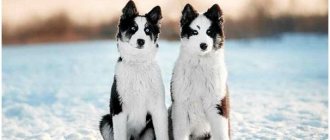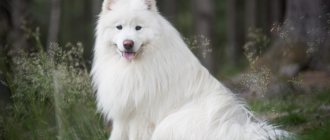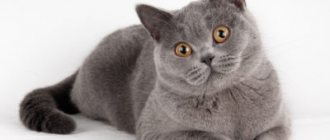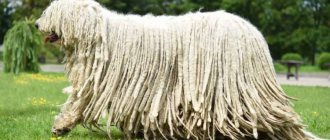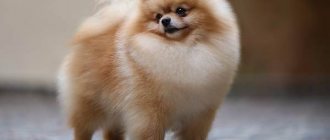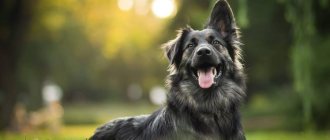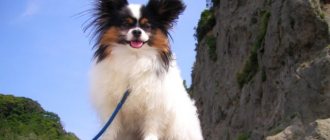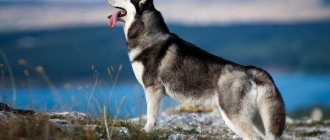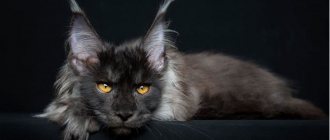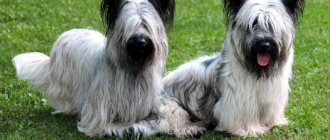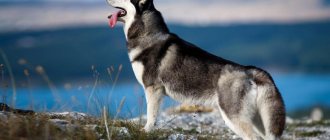Hachiko's story, known throughout the world, attracted attention to Japanese dog breeds. Although there are relatively few varieties bred on the islands, they are all attractive in appearance and character, intelligence and ability to quickly absorb knowledge. The small Japanese group has a number of specific features common to all its representatives. The development of the breeds is due to the prolonged isolation of the Land of the Rising Sun. The minimum contact with the outside world led to the fact that Japanese dogs did not interbreed with other varieties.
Japanese dogs attract with intelligence and beauty
Origin story
In Japan there is a legend about the origin of Kishu. It says that one day a hunter came out with a wounded she-wolf and, in gratitude for her help, he asked her for a puppy. The she-wolf fulfilled the request. This wolf cub was raised by a human and became the progenitor of all kishu. He was highly valued by hunters for his fearlessness, endurance and extraordinary intelligence.
Dog handlers do not believe the legends; they believe that Kishu descended from the indigenous Spitz-like Japanese dogs that appeared on the islands more than 3,000 years ago. How the Kishu breed was formed in the mountainous regions of the Kii Peninsula in the territory of the Kishu Principality. Hence its name. Today these are Nara, Mie and Wakayama prefectures. Hunting scenes involving muslin-like dogs date back to the 13th and 14th centuries.
The Kishu breed has been recognized as a National Treasure by the Japanese Dog Preservation Association Nihonken Hozonkai (Nippo).
For a long time, there were several types of dogs, which were called according to their place of origin: Kumano Inu, Taiji Inu, etc. The breed received the general name Kishu after official recognition and approval of the Nippo standard in 1934. At the same time, many other Japanese dog breeds were recognized. The breed was recognized by the International Canine Association (FCI) in 1982.
Usage
Kishu is a hunting dog, which is used mainly for hunting large game: wild boar, deer, bear. It is well suited to work in deciduous forests and mountainous areas. The tasks of the kishu during the hunt are to find the trail of the animal, track it and hold it until the hunter arrives.
If an animal tries to leave, the kitty will often jump on top of it and bite it with its teeth. However, she understands that she must only hold, and not kill. To do this, the dog must have sufficient courage, dexterity, strength and anger. Modern hunters often take a pair or a pack of dogs with them.
Unlike many other hunting dogs, the Kishu is capable of restraining the animal with both bark and bite.
A properly raised Japanese Laika develops a close bond with its owner. She is obedient, hardy and efficient, which makes her not only a wonderful assistant to the hunter, but a companion for various sports: agility, coursing, tracking.
In Japan, three intra-breed types are distinguished, depending on the object of hunting. The wild boar is hunted with strongly built, muscular dogs that have a special malice towards the animal. Deer are hunted if they are slender, easily excitable, and capable of long and fast running. Less common are small kishu with character and flair, which allows them to be used in working with small game and birds.
What is the Nippo organization?
Japanese dogs are under the patronage of the “Society for the Protection of Aboriginal Dog Breeds” (abbreviated name - Nippo), created by dog enthusiasts in 1928 with the aim of preserving indigenous breeds that were the result of hybridization with the local - now extinct - subspecies of wolves.
This measure was very timely, since by that time purebred indigenous dogs had been practically replaced by animals of European breeds imported into the country at the end of the 19th century, after the end of Japan’s self-isolation policy.
The Nippo Association Register currently lists six breeds that have been awarded the status of National Treasure of Japan:
- kai;
- kisyu;
- Akita Inu;
- Shiba;
- Shikoku;
- Hokkaido.
Appearance
Kishu is a medium-sized dog, strongly built, compact, and well-balanced. It has a wedge-shaped head typical of Japanese breeds, erect ears and a well-furred tail, which curls into a ring on the back or hangs down like a sickle. Sexual dimorphism is well expressed.
- Height at the withers of males - 52 cm, weight - 20-27 kg;
- The height at the withers of the bitches is 46 cm, weight is 14-23 kg.
The head is of proportional size with a wide forehead and a rather sharp stop. The muzzle is shaped like a tapering wedge. The nose is black; in white dogs it may be flesh-colored. The bridge of the nose is straight. Lips fit tightly. Scissor bite. The eyes are small, triangular in shape, dark brown in color, and widely spaced. The ears are triangular in shape, small, erect, slightly tilted forward. The neck is massive and muscular.
Body with strong bones and well-developed muscles. The height to length ratio is 10 to 11. The back is straight and short. The loin is wide. The chest is deep with moderately sprung ribs. The belly is well tucked. The tail is set high, reaching the hocks, thick, carried in a sickle shape or curled in a ring over the back. The limbs are straight, strong, with strong bones and joints. Paws with tightly knit toes, thick and elastic pads. The claws are strong, preferably black.
The coat is straight, coarse with a soft and dense undercoat. The hair on the cheekbones and tail is longer. Colors:
- White;
- Red (rich red);
- Sesame (sesame) - red or fawn coat with black tips on the hairs.
The brindle color has not been seen in the breed since 1945. Probably, its abandonment is due to the use of the dog for hunting. Whites are more noticeable in the forest and on the back of a dark animal.
Tosa Inu
The Tosa Inu or Japanese Mastiff is a unique Japanese dog breed in many ways. This uniqueness is explained by the fact that Tosa Inu is the only Molosser of its kind, whose homeland is the land of the rising sun.
Tosa Inu
The Tosa Inu breed is inextricably linked with such an ambiguous part of Japanese life as dog fighting. Breeders started breeding these animals deliberately - in order to be able to defeat fighting dogs imported from Europe, which were superior to Japanese individuals in strength and size. The Tosa Inu contains the blood of several large breeds, such as:
- Bulterer;
- Pitbull;
- Bulldog;
- English Mastiff;
- Poyntner;
- German dog.
Dog fighting is currently banned in Japan.
Different crossings yielded results of varying degrees of success, but ultimately the breeders were able to create a strong, healthy dog that became an excellent fighter.
Character traits
The development of Tosa Inu's character largely depends on the owner and his will. If you direct your pet in the right direction and devote enough time and effort to training, the dog will grow up loyal, kind and open. Among the details that briefly describe the ambiguous personality of the Japanese Mastiff, we highlight the following:
Despite the fact that the Japanese Mastiff was born a warrior, by temperament he can rather be classified as phlegmatic. Correctly raised Tosa Inu dogs are an example of noble calm and self-control;
the status of a fighting breed presupposes that the person taking the Japanese Mastiff into his family has an idea, and most importantly, experience in training this kind of dog. Inexperienced owners run the risk of simply “losing control”; devotion to the owner imposes certain restrictions on Tosa Inu training
It is important that a dog of this breed be trained by a person for whom the dog has developed affection and respect. Otherwise, Tosa Inu will begin to protest and refuse to follow commands;
alertness
Fighting qualities encourage the mastiff to be wary of strangers. Wanting to save the life of the owner, this dog can cause serious injuries to the “opponent”. It is important to remember this when inviting your friends or colleagues to your home.
Color
Tosa Inu's coat is very short and dense - exactly what a fighting dog needs during fights. Among the colors that correspond to the breed standard are the following options:
- ginger;
- apricot;
- brindle;
- black;
- pale yellow.
Most Japanese Mastiffs have a uniform coat color
The most common are red-brown Japanese Mastiffs. A uniform color option that does not allow uneven color distribution is considered classic. However, representatives of the breed are allowed the presence of light spots on the chest and limbs.
Character and behavior
Kishu, like many other Japanese dogs, has an independent and balanced character. In everyday life he behaves calmly and calmly, but thanks to his flexible nervous system he is ready to immediately get to work when required. The Japanese Laika needs very good education and early, comprehensive socialization. Ignoring this can lead to behavior and obedience problems. Kisyu perceive any other living creature as prey, and are often pugnacious. Peaceful coexistence is possible only with those animals with which the dog grew up together, subject to proper upbringing.
Hunting behavior is very well developed. Kishu are brave and determined, quite easy to train, and show a passion for pursuit and anger towards the beast. They are highly territorial, making them good watchdogs. They do not have the ability to perform protective and guard duty. They are wary of strangers. They bark a little in everyday life.
The Japanese husky has an extraordinary intelligence, which is especially noticeable at work. When hunting, the dog shows unprecedented intelligence, and, if necessary, cunning. She can guard prey for a long time or change her work style if circumstances require it. Loyal to the owner. Attached to all family members, but rarely distinguished by outstanding fidelity.
Kai-ken
This breed has several names, but the names most often used to designate it are “Kai-ken” or brindle dog. The calling card of the breed is its unusual coat color, which in part actually resembles the skin of a tiger. Like other native breeds, brindle dogs were raised in isolated geographical conditions, which allowed them to successfully maintain the purity of the breed. Since ancient times, Kai-kens have been used to hunt various wild animals, such as wild boars, deer and even bears.
Kai-Ken
The negative side of such isolation was the small number of livestock. The Kai-ken is considered a very rare dog even in Japan itself, where representatives of the breed are carefully protected. The reason for the sharp decline in the breed is the temporary indifference of the Japanese to indigenous dogs, associated with the importation of new European individuals back in the twentieth century.
Character traits
The character of dogs of the Kai-ken breed was formed inextricably linked with their main function - pursuit of prey and assumes the presence of the following traits:
friendliness. The hunter's habits do not prevent brindle dogs from showing their good nature. Kai-ken are open to adults and patient when playing with children. At the same time, it is not recommended to keep these dogs under the same roof as cats;
devotion to the owner. Like other hunting breeds, the Kai-ken literally lives for one person, to whom he gives most of his attention. However, brindle dogs develop such relationships only with those owners who do not allow themselves unnecessary things (screams, pressure and other methods of rough influence); activity
In the absence of hunting, it is very important for Kai-kens to be able to waste their energy reserves. Therefore, keeping such pets in an apartment in the city center is inappropriate
Brindle dogs are not intended for large capitals;
Best articles: What is called a lagoon in geography? Definition and examples
intelligence. Loyalty and intelligence are an excellent combination when training a pet, especially if the brindle dog trusts its owner in everything and follows his instructions with pleasure.
Health status
Tiger dogs, like many other native breeds, have strong immunity. The purity of the gene allowed Kai-ken dogs to protect themselves from predisposition to many diseases. Unfortunately, even such strong purebred dogs can have health problems.
The most common pathologies for brindle dogs are:
- hip dysplasia;
- elbow dysplasia;
- hyperthyroidism;
- retinal atrophy.
Representatives of the Kai-Ken breed are susceptible to various forms of dysplasia
With proper attention from a veterinarian, all these ailments can be avoided or at least their progression can be significantly slowed down.
Content Features
Kishu are not demanding in terms of housing and nutritional conditions; they are unpretentious, hardy, have high adaptive qualities, and can easily tolerate cold. They are not adapted to city life and will not feel well in an apartment. The best option for a dog would be to live in a private home and use it for its intended purpose.
It is important for the Japanese Husky to have adequate living space, good exercise and the opportunity to hunt to satisfy its natural talents. If this is not a real hunt, she needs to find an alternative.
The dog does not require special care. Grooming comes down to standard care procedures:
- The coat is combed 1-2 times a week;
- Bathed once every 3-4 months or less;
- Ears are examined weekly and cleaned as needed;
- Claws are trimmed as they grow, if they do not grind down on their own;
- Monitor the condition of the eyes and teeth;
Recognized by Japan
These breeds were bred within the country and received international recognition from the FCI and local cynological associations, but are not considered native Japanese.
Hin
The ancestors are considered to be Pekingese, but there are breeds derived from spaniels. Small, graceful, with a wide muzzle. Covered with long, silky and straight hair with a poorly developed undercoat.
The Chin is an ideal companion that easily adapts to any owner's lifestyle. They are delicate and friendly, but do not tolerate familiarity from strangers. They are easy to train if they are constantly encouraged.
Tip: Chins are considered feeding dogs, i.e. those that learn with the help of treats. However, such a statement is wrong. In fact, this breed categorically does not like to learn for food and this often becomes the cause of misunderstanding between the pet and its owner.
Ideal for keeping in an apartment and barks very rarely. Gets along well with animals and is tolerant of children.
You can buy a Chin puppy for 25,000 rubles or more.
Japanese Spitz
A small, elegant dog 30-38 cm at the withers. Brought out in the 20s by crossing different breeds of Spitz. The “Japanese” have a thick, snow-white coat with a thick undercoat.
These are active, playful, lively pets that are distinguished by their courage and devotion. They are suitable for apartments because they are easy to care for, bark very rarely and do not have the characteristic “dog” smell. They are sociable and need affection and attention. They love children and enjoy playing with them.
The price of a Spitz is from 30,000 rubles.
Tosa Inu (Japanese Mastiff)
Tosa Inu were developed by crossing local breeds with European mastiffs, Great Danes, St. Bernards and bulldogs. The goal was to get pets for popular dog fighting in the land of the rising sun - persistent, strong, silent, powerful, hardy, vicious.
Japanese Mastiffs are a serious fighting breed. They do not put up with other pets, have difficulty recognizing human leadership, are stubborn and therefore are not suitable for novice dog breeders. Only experienced breeders with strong leadership qualities can cope with Tosa Inu.
Japanese Terrier (Mikado Terrier, Kobe Terrier)
A rare breed even for its historical homeland. Sensitive, kind companion. This small (30 to 38 cm at the withers) dog is very careful, fast and energetic. Doesn't like people raising their voices at him. It has excellent hearing, so it is considered a good guard dog, despite its size.
Jomon-shiba
Almost unknown abroad. Jomon-shiba are not recognized by the Nippo association. They look like a small wolf and have the same unrivaled hunting instinct. They are independent, so dog experts recommend starting to socialize your pet as early as possible.
- Japanese dog names: boys and girls
- Hokkaido (Ainu) - Japanese dog breed
- Japanese Spitz
Where to buy a Kishu puppy
In Japan, the Kishu population numbers 11,000-13,000 individuals. About 300 puppies are registered per year. Finding a Japanese Husky outside of Japan today is not difficult. A lot of dogs have been exported to Europe and the United States of America in the last 10-15 years. Given the growing popularity of Japanese breeds, it is not surprising that the number of dogs and breeders is growing every year. Japanese huskies are found in Russia, France, Spain, Germany, the Netherlands, Poland, Slovenia and some other countries.
Price
In Japan, the price of a Kishu puppy varies widely. Judging by the advertisements - 10,000-210,000 yen, the average is about 160,000 yen. (approximately $1,400). In Europe, they usually ask for 1,500-3,000 euros for a baby of a rare breed. In Russia, the average price of a puppy from nurseries is 100,000 rubles.
Japanese Chin
These decorative animals were bred in Japan and have become very popular around the world. To breed them, Tibetan spaniels and Pekingese were used. Japanese Chins are the favorite dogs of the imperial family and continue to live in the palace today.
The animals have small ears and a tail with thick hair. With proper combing, there will be no problems with shedding.
In Japan, these dogs symbolize Buddha. In ancient times, only members of the nobility owned chin. Today these dogs are used as companions. Representatives of the breed are quite intelligent and have a good disposition. They get along well with children and make contact easily. They are able to exist in small spaces, so they are suitable for keeping in a small apartment. They are easy to train, the main thing is not to let the chin get bored.
Best articles: Which sea is the smallest in area on Earth, in Eurasia and Russia?
List of suitable nicknames
The puppy’s name should be given to him sonorously and not long, so that the pet can quickly remember it. Some breeders require that the name of the Shiba Inu include the name of the kennel and the nicknames of the parents. In this case, the passport nickname will be complex, but in everyday life you can use its simplified version.
Exotic nicknames with an oriental touch are suitable for Shiba Inu:
- Ask, Auchi, Buran, Belle, Beauty, West, Velda;
- Grammy, Girr, Giro, Derk, Eks, Ekka;
- Julie, Joseph, Zif, Zaura, Irs, Yokki, Iota;
- Casta, Queen, Roots, Luke, Link;
- Mazur, Malva, Mint, Molly, Norris, Nyagu, Narsis;
- Olipmic, Ora, Pegasus, Prana, Ross, Rakumi;
- Samura, Sate, Takeshi, Tracy, Unta, Uncha, Uchi;
- Franz, Fiji, Habi, Hooch, Hill, Hitach;
- Cicero, Zweig, Cherry, Chaos, Shitani, Storm;
- Eiris, Eriming, Yuska, Jurvis, Yatago, Jania.
Health
Shiba Inus were formed in cold climates, so the dogs have stable immunity. But there are a number of hereditary diseases characteristic of this breed:
- allergy;
- joint dysplasia;
- cataract;
- hypothyroidism
If your pet’s behavior is no longer the same as before, or the body temperature has increased, it is better to contact a veterinarian.
Expert opinion
Anna Abramenko
An avid dog lover. Experience in veterinary medicine since 2009.
Ask a Question
To avoid life-threatening infections such as rabies and plague, dogs are required to be vaccinated. Timely immunization measures will protect your pet from terrible diseases.
What is the price for it and how to choose a puppy?
A tried and true method is to contact an official club. Especially if you are going to fight for the championship title. When you get to the offspring, choose where there are the fewest babies. Also decide in advance what you need your four-legged friend for. If it’s just for fun, then it’s enough to find a conscientious dog breeder.
To reproduce your own kind, it is better to take a baby from a nursery. In both cases, general recommendations will help you:
- Take an interest in the pedigree, certificates and prizes of your parents, and genetic predisposition to certain diseases.
- Do not take a toddler from mom and dad who are related by blood. This will negatively affect his development.
- Take a closer look at the nursing female and chat with her. Check if she is good at getting closer to you. This is a prototype of your ward in the future, so draw your own conclusions.
- Observe how the baby eats, plays, and interacts with her sisters and brothers.
- Check the cleanliness of the skin, mucous membranes and teeth. A healthy puppy is a little plump, but at the same time he is active.
- If the baby, when looking at you, expresses curiosity and a desire to make contact, he is already sincerely yours.
Their breeding is carried out mainly by professionals, because the price to pay for mistakes is too great. The cost of a healthy puppy starts from $1,000 , so you are unlikely to come across an incompetent breeder selling non-purebred individuals. If his ancestors had awards and titles, you will pay another 1-2 thousand. Then you will have a better chance of winning the exhibition.
Description
The dog's physique is proportional to:
- strong small head;
- elongated muzzle, reminiscent of a fox;
- straight back without deflection with moderately developed muscles;
- the tail curls into a ball;
- ears are erect, according to the standard.
In the description of the breed, a distinctive feature worth noting is its funny facial expressions: the dog can really smile. When properly raised, the Shiba Inu has courage, a strong character, and is friendly towards children. The breed's character is characterized by such qualities as curiosity, sociability, and a desire to learn new things.
Shiba Inus are capable of producing amazing sounds that resemble human speech.
Japanese Terrier
This dog breed is considered rare even in Japan. Their number does not exceed 2000 individuals. When breeding the breed, Dutch and English fox terriers and Italian greyhounds were used, which were crossed with local dogs.
Read Dogs that do not cause allergies - 20 breeds
They began to be bred at the beginning of the last century. The parameters of this breed were approved only in the 30s. The Japanese Terrier is recognized as an official breed throughout the world. But these dogs did not gain much popularity.
These lapdogs are usually used as companions, but they can also be used as hunting dogs. Japanese Terriers are adapted to work on land and in water. They are distinguished by their good nature and sensitivity. The breed gets along well with children. With proper training, it can be used as a watchman or hunter.
American Akita
The American Akita was bred from the Akita Inu. The first representatives from Japan were brought to the United States after World War II, where they quickly became popular.
To get a new breed of dogs, Americans crossed Akitas with German shepherds and mastiffs. The resulting breed was called the Great Japanese Dog. It differs from its eastern relatives in its massive build, variety of colors and more flexible character.
Otherwise the breeds are similar. American Akitas are as freedom-loving and independent as their Japanese relatives. Care and maintenance are also the same: a large Japanese dog is kept in an apartment or outside the city, washed several times a year, and combed every week.
Reviews
Maria, Kerch: “My dog is three years old. We've been through a lot together. Damaged shoes, torn wallpaper, broken flower pots. One day the pet got off its leash and got lost. The Shiba Inu was found the next day in another area of the city. But Elvis matured and settled down. Now he is my favorite boy."
Anna, Kostroma region: “In our area, the Shiba Inu is a strange breed. No one has ever heard of such dogs. The neighbors thought that we had brought a well-fed fox cub. The pet immediately showed itself as a guard. No one passes into the yard unnoticed; Ranch senses the approach of a stranger a mile away.”
Ivan, Vladivostok: “I myself lead an active physical lifestyle. I wanted the dog to share my interests. Now I have a companion with whom we go long distances to the mountains on weekends.”
A beautiful Shiba Inu dog will delight its owner with its presence for many years. The pet will respond to care with boundless devotion, fidelity, and selfless love. For an easy-going person, such an animal will become a faithful companion.
Color variations - the most popular colors
The coat of the breed has coarse guard hair and a lush soft undercoat. The longest fur is on the tail of an animal. In accordance with the standards, three color options are allowed:
- ginger;
- black and tan;
- zonal (sesame or sezar).
Hovawart (dog breed): description of the breed, differences
The first is considered the most popular, the other two account for about 20% of animals. Regardless of the main option, “urajiro” (“urajiro”) is considered mandatory - the presence of white hair on the throat, neck, tail and paws. White fragments should also be present on the sides of the muzzle and under the belly.
Important! The most valuable are Shibo Inu dogs with bright, rich colors. However, light versions of the red tone - sand, peach - are also allowed by the standard.
White representatives of the breed are very beautiful, but they are not recognized by the standard, therefore they are not allowed for breeding and exhibition activities.
Charming Shiba Inus will become faithful companions for family people
Japanese Chin
The Japanese Chin is a toy dog bred in Japan and recognized throughout the world. A descendant of spaniels from Tibet in the Land of the Rising Sun entertained the emperor and his court. These were dogs with a sacred status. They were started by representatives of the nobility and nobility, legends were formed about chins, and execution was provided for their theft.
Pedigree breeders of Japanese dogs appeared only in the 14th century, and in 1957 the breed was officially approved by the Federation of International Cynologists. Chins are small in size, long-haired, with a wide rounded head and a short muzzle. The eyes are large and set wide apart, the ears are of medium length and hang downwards, the tail is always thrown over the back.
Caring for dogs is very important, so learn more about how to properly trim nails, make a pattern for overalls, choose a toy, clipper, collar, furminator, and find out what trimming and grooming are. Breed standard:
- height - up to 25 cm;
- weight - up to 3 kg;
- color - white-black;
- life expectancy is 10-12 years.
The only thing that can upset a Chin is being ignored by family members and inattention. Will never tolerate rudeness or raising one's voice
Japanese Chins are highly trainable and, if respected by their owner, are ready to reveal all their best qualities.
Advantages:
- cheerfulness;
- the ability to adapt to the rhythm of life of the owners;
- ease of training.
Flaws:
can be aggressive if not raised correctly.
Did you know? Dogs of this breed are often featured in films. From a wide range of films one can name such masterpieces as “Mimino”, “Stone Flower” and “2012”.
What is the smallest dog breed in the world?
The world's smallest Chihuahua dog, whose results are included in the book of records. The little one named Millie is only 6.53 cm tall. The weight of the smallest dog in the world is 170 grams.
Caring for baby Millie is not easy, but the owners, a married couple from Puerto Rico, dote on her. The main difficulty for them is losing their baby in the garden or at home. Most of the chicks, despite their tiny size, are aggressive towards strangers.
Hokkaido
This breed of dog is considered Spitz-type. It originated on the island of Hokkaido and was originally used for hunting bears. The breed is quite small. Because of this, the price of these animals is quite high. Even in Japan their numbers are small.
Dogs of this breed have a developed wide skull and a flattened muzzle, they have pronounced muscles and strong hind limbs. The breed formed almost independently without the participation of breeders. All the characteristic features of the Hokkaido breed were formed as a result of the influence of climatic conditions. They retain the features of primitive dogs.
All the benefits of small dogs
The demand for pocket dogs is growing every year. Pets have a beneficial effect on the upbringing and development of children. Tiny creatures are devoted to those who care for them. Despite their size, they are lively and brave. We are always ready to defend ourselves if the owner is in danger.
Friendly, cheerful creatures lift your spirits. Looking at them, only positive emotions appear. Abroad they are considered four-legged doctors.
Positive creatures have an incredible healing effect on humans. Pets don't require a lot of space. They feel comfortable in a small living space, there are many positive aspects.
The main advantages of mini dogs:
Compact size. Despite his small height and weight, the pet has a big heart. Such a tiny animal will give its owner his love and become a full-fledged member of the family. No fear of heights. Fearless animals bypass their larger counterparts: they are not afraid of heights, and, it seems, are even ready to make a parachute jump.
They eat little. The small pet, although picky about food, eats little. They go to diapers. When there is no time to walk with her, she easily learns to go to the tray or diaper. They love affection. Few people would think of coddling a Great Dane or a Rottweiler.
With small dogs you can afford such familiarity. They love to be in the arms of their owner and are always happy when they are petted. Minimum dirt. There is little smell or fur in the home from a miniature dog.
Portability. The world's tiniest dogs fit in a purse. You can take it with you on a visit or to the store, or transport it in transport without any hassle. Long-lived. Such “babies” have a longer life expectancy than their larger relatives.
Sakhalin Husky
The Japanese call Sakhalin or Gilyak Laikas karafuto-ken. Initially, the breed was native to the Amur region and the Sakhalin region. But in the 30s of the twentieth century, they were deliberately exterminated from the house. At the same time, the dogs were brought to Japan, where they worked on their awakening.
Sakhalin Huskies are considered an endangered breed. Work is still underway to restore and increase the number.
Sakhalin residents are sled dogs. They were also used to attract bears and sea animals. They are smart, brave and very resilient. In terms of working qualities, they are superior to Siberian Huskies, Malamutes and other breeds.
The breed went down in history thanks to an extraordinary event. In 1958, Japanese researchers had to leave 15 Sakhalin huskies in Antarctica. Scientists hoped to restore them soon, but due to deteriorating weather, they were able to return only a year later. Surprisingly, people found two surviving dogs. In honor of them and the dead dogs, a monument was erected in Japan and two films were made: “Antarctica” and the American remake of “White Captivity”.
Nutrition
At an early age, puppies are fed 5-6 times a day, from two to four months - 4-5, up to seven - 3-4. Upon reaching 8 months of age, the dog is transferred to two meals a day. And this regime should be observed constantly.
A common question that a novice breeder has is: which food is better, natural or dry. Both types of nutrition have pros and cons. Adherents of granulated ready-made feeds are inclined to this option due to its ease of use. They are confident that the pet is provided with the necessary proteins, fats, carbohydrates, and microelements. But high-quality food is expensive.
Expert opinion
Anna Abramenko
An avid dog lover. Experience in veterinary medicine since 2009.
Ask a Question
When using dry food, monitor your pet's drinking regime. Fresh water should always be in your pet's bowl.
People who feed natural food believe that only fresh food will give the dog everything it needs. But in order not to harm your pet, it is important to know the list of necessary and dangerous products.
List of useful ingredients:
- beef, rabbit meat;
- sea fish;
- fermented milk products;
- fresh vegetables and fruits;
- cereals - rice, buckwheat.
List of prohibited products for the breed:
- chicken meat;
- River fish;
- legumes;
- sweets;
- smoked and spicy dishes;
- eggs;
- spices.
Proper nutrition will ensure your pet has a long and healthy life. When feeding the Shiba Inu naturally, vitamins and microelements are added to the food, which must be selected by a veterinarian.
Do not mix natural and dry food.
Selection rules
To purchase a Shiba Inu puppy for the purpose of further breeding, it is advisable to contact a nursery whose owners will guarantee the purity of the breed. Specialists must answer all questions about caring for and raising a dog.
Expert opinion
Anna Abramenko
An avid dog lover. Experience in veterinary medicine since 2009.
Ask a Question
When choosing a pet, you should pay attention to the activity of the Shiba Inu. It is not recommended to take a baby who shows signs of cowardice. The puppy should have clean eyes and ears, no discharge and shiny, bald hair.
It is also advisable to look at the pet’s parents and find out what kind of dog the Shiba Inu will turn into when it grows up. An inspection of the room where the babies were born and live with their mother will also give a complete picture. The dog's bed should be clean and well-groomed. A decent breeder will not interfere with the arrival of a buyer. If he refuses to meet you directly at the kennel, then it is better to refuse to purchase a dog in this establishment.
